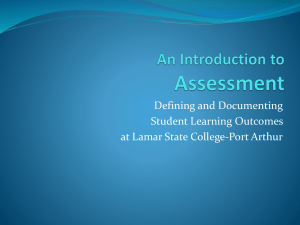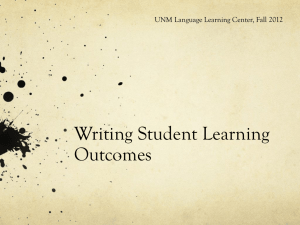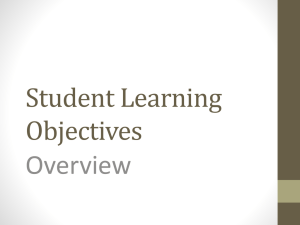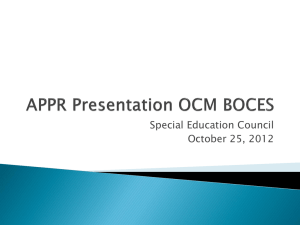Ready Set SLO 5 -11-12
advertisement
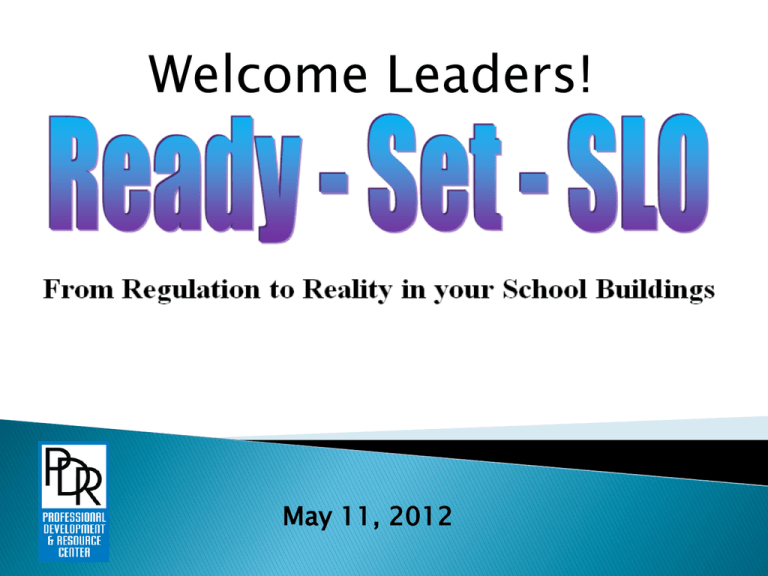
Welcome Leaders! May 11, 2012 SLO Motion Feeling SLO? SLO Boat to China Take a walk on the SLO side…. SLO Hell Consolidations Current Reality SINI List Race to the Top Dignity for All Students Student Learning Objectives College & Career Ready Thank you for leading the learning! Identify and explain the purpose of SLO(s) and their essential components Identify who will have student provided growth scores(SPGS) and who will have SLO(s) Explain the process for writing (setting) SLO(s) Identify steps in district planning and implementation of SLO(s) for the growth component of teacher evaluation Determine which teachers in your school buildings will need an SLO and which teachers will get SPGS Create an SLO concepts and information by putting our heads together to check our understanding what actions can/should be taken now What questions do we have now that the Network Team can ask/clarify? www.btboces.org PD & Resources Principals Center principals center 20 - 25 Growth + 20 - 15 Local Student Learning Objectives + 60 Other Measures =100 • Learning Content • Baseline • Population • Rationale Diagnostic Assessment • Interval of Instructional Time (year/semester/quarter) • Evidence • Target • HEDI Criteria SPGS=State Provided Growth Score Provided only to 4-8 ELA and Math teachers Everyone else=SLO (1 or more) Teacher by Grade and Subject: K-2 Teachers Growth is Stateprovided SGP/VA No Grade 3 Teachers No 4-8 Common Branch/ELA/Math Teachers 4-8 Science and Social Studies Subject Teachers Yes No 4-8 Other Subject Teachers No 9-12 Core Subjects, Regents Subjects and Regents Equivalents As available. 9-12 Other Subject Teachers No Teachers with a Mix of Sections/Courses With/Without State-Provided Growth Measures Yes, if greater than or equal to 50% of sections/students are covered by SPG/VA Growth is SLO 1 SLO for ELA (literacy and writing) 1 SLO for Math (unless teacher focuses on single subject area) 1 SLO for ELA (literacy and writing) 1 SLO for Math (unless teacher focuses on single subject area) Not applicable unless less than 50% of students are covered by SPG/VA. If so, then same as below (4-8 Science/Social Studies/Other) SLO for each subject/assessment-(SLOs must cover classes with largest numbers of students until a majority of students are covered.) 1 SLO for each subject/assessment-(SLOs must cover classes with largest numbers of students until a majority of students are covered.) 1 SLO for each subject/assessment-(SLOs must cover classes with largest numbers of students until a majority of students are covered.) If less than 50% covered by SGP/VA, then SLOs will be used. First, SLOs must use SGP/VA where available; then create SLO’s for largest sections without SGP/VA until majority of students are covered. Teachers by Setting: Self-Contained Teachers (ESL/Bilingual, students with disabilities) Any Co-Teachers -Both teachers must have the same growth measures Any Push-In, Pull-Out (AIS, SWD, ESL, etc.) Growth is Stateprovided SPG/VA Yes, if greater or equal to 50% of students are covered by SGP/VA As applicable, and as NYSED can track multiple teachers of record As applicable, NYSED has teacher of record rules for dosage Growth is SLO If less than 50% is covered by SGP/VA, then SLOs will be used: -1 SLO for ELA (literacy and writing) -1 SLO for Math -unless teacher focuses on another subject area If District cannot track multiple teachers of record, then SLOs will be used: -For Common Branch teachers: 1 SLO for ELA (literacy and writing) and 1 SLO for Math -For other subject area focus teachers: set SLO for relevant area If no State-provided measure, then SLOs will be used: -1 SLO for subject area focus -Or consider using group/team growth on State assessment; collaborative goalsetting with classroom teachers Teachers with Students Taking These Assessments: NYSESLAT Growth is Stateprovided SGP/VA if: Growth is SLO if: • 50% or more of students in teacher’s course load take State ELA assessment OR • If NYSED develops a growth measure from NYSESLAT (in the future) • If this is an ELA teacher required to set SLOs, and 10 or more students take NYSESLAT as evidence (Additional SLOs are still also set for ELA (literacy and writing) and must use State assessment where applicable. • Teacher is ESL specialist and NYSESLAT is most appropriate measure of student learning. NYSAA 50% or more of students in teacher’s course load take State assessment If this is a teacher required to set SLOs, then teacher will set 1 of their SLOs using NYSAA performance assessment as evidence. Additional SLOs are also set based on subject area taught (e.g. ELA, Regents, Math) What teachers will need an SLO? What is the significance of the “50% rule?” Which teachers in your district will have an SLO? Develop a list of teachers who will need SLO(s) in your building and determine in what area(s). Excel spreadsheet on Principals Center Teacher Rosters/Student Numbers How will SLOs get set? What are some of the decisions districts need to make to complete SLOs? Decision Points: Now that we know who needs one… Which used? How assessments will be will assessments be built? Is there a State test? Must be used for SLO Post Assessment YES NO Are you going to use an assessment from the State approved 3rd party list? Are you going to design a district or regional assessment? Teacher by Grade and Subject: K-2 Teachers Grade 3 Teachers Growth is Stateprovided SGP/VA Pre and Post Assessments needed for ELA and Math Pre Assessment needed, State exams used for Post Assessment 4-8 Common Branch/ELA/Math Teachers 4-8 Science and Social Studies Subject Teachers 4-8 Other Subject Teachers No Yes Pre and Post Assessments needed, State Tests used where applicable for Post Assessment 9-12 Core Subjects, Regents Subjects and Regents Equivalents 9-12 Other Subject Teachers No No As available. Pre and Post Assessments needed Teachers with a Mix of Sections/Courses With/Without State-Provided Growth Measures No No Yes, if greater than or equal to 50% of sections/students are covered by SPG/VA Growth is SLO 1 SLO for ELA (literacy and writing) 1 SLO for Math (unless teacher focuses on single subject area) 1 SLO for ELA (literacy and writing) 1 SLO for Math (unless teacher focuses on single subject area) Not applicable unless less than 50% of students are covered by SPG/VA. If so, then same as below (4-8 Science/Social Studies/Other) SLO for each subject/assessment-(SLOs must cover classes with largest numbers of students until a majority of students are covered.) 1 SLO for each subject/assessment-(SLOs must cover classes with largest numbers of students until a majority of students are covered.) 1 SLO for each subject/assessment-(SLOs must cover classes with largest numbers of students until a majority of students are covered.) If less than 50% covered by SGP/VA, then SLOs will be used. First, SLOs must use SGP/VA where available; then create SLO’s for largest sections without SGP/VA until majority of students are covered. Teachers by Setting: Self-Contained Teachers (ESL/Bilingual, students with disabilities) Any Co-Teachers -Both teachers must have the same growth measures Any Push-In, Pull-Out (AIS, SWD, ESL, etc.) Growth is Stateprovided SPG/VA Yes, if greater or equal to 50% of students are covered by SGP/VA As applicable, and as NYSED can track multiple teachers of record As applicable, NYSED has teacher of record rules for dosage Growth is SLO If less than 50% is covered by SGP/VA, then SLOs will be used: -1 SLO for ELA (literacy and writing) -1 SLO for Math -unless teacher focuses on another subject area If District cannot track multiple teachers of record, then SLOs will be used: -For Common Branch teachers: 1 SLO for ELA (literacy and writing) and 1 SLO for Math -For other subject area focus teachers: set SLO for relevant area If no State-provided measure, then SLOs will be used: -1 SLO for subject area focus -Or consider using group/team growth on State assessment; collaborative goalsetting with classroom teachers Teachers with Students Taking These Assessments: NYSESLAT Growth is Stateprovided SGP/VA if: Growth is SLO if: • 50% or more of students in teacher’s course load take State ELA assessment OR • If NYSED develops a growth measure from NYSESLAT (in the future) • If this is an ELA teacher required to set SLOs, and 10 or more students take NYSESLAT as evidence (Additional SLOs are still also set for ELA (literacy and writing) and must use State assessment where applicable. • Teacher is ESL specialist and NYSESLAT is most appropriate measure of student learning. NYSAA 50% or more of students in teacher’s course load take State assessment If this is a teacher required to set SLOs, then teacher will set 1 of their SLOs using NYSAA performance assessment as evidence. Additional SLOs are also set based on subject area taught (e.g. ELA, Regents, Math) 1. 2. 3. 4. 5. Develop secure, common “pre and post assessments” Compare assessments to ensure “comparability and rigor” Develop common systems for defining “growth/ achievement” Design scoring bands Create collaborations for scoring as needed ◦ Each course ultimately has a Regents as target ◦ High probability that final exams exist ◦ Common Core alignment Proof of Concept Art, Music, PE, Health, Special Education, Library Purpose: 1. To develop sample SLO assessments for Art, Music, PE, Health, Special Education 2. To define additional questions about SLOs and assessment related to them 3. To request feedback from SED about the quality of the samples and about the questions Proof of Concept Art, Music, PE, Health, Special Education, Library Then: Use samples and answers to questions to develop common “cluster” assessments for Art, Music, PE, Health, Special Education, Library When: Summer, 2012 What are the approved options for assessments? What assessment decisions have been made? What assessments do we currently have? What is still undecided? Cluster group meet and share ◦ Go to designated cluster area ◦ Meet by Elementary, Middle, High Principals ◦ Discuss: 1. What assessment decisions have been made? 2. What assessments do we currently have? 3. What is still undecided? E D A B C Set a target for the average % of mastery of standards across entire class/section. Set a target for the average scale score gain (points)from baseline to end across entire class/section. Set differentiated growth targets by student Training SLO Target Approach 1: Set a growth to mastery target. 85% of students, including special populations, will grow to score 75% or higher on the summative assessment for the selected standards. Student Pre-Test Score Summative Target Student A Student B Student C 10 20 5 75 75 75 Student D Student E Student F 0 30 10 75 75 75 36 Training SLO HEDI Approach 1: Set ratings using the percent of students meeting a collective target (e.g., 80% mastery). 85% of students, including special populations, will grow to score 75% or higher on the summative assessment for the selected standards. Highly Effective* (18-20 points) 91-100% of students grew to score 75% or higher on the summative assessment rubric measuring the selected standards 98-100=20 points 95-97=19 points 91-94=18 points Effective* (9-17 points) 85% -90% of students grew to score 75% or higher on the summative assessment rubric measuring the selected standards 90=17 points 89=16 points 88=14-15 points 87=12-13 points 86=10-11 points 85=9 points Developing* (3-8 points) Ineffective* (0-2 points) 79% - 84% of students grew to score 75% or higher on the summative assessment rubric measuring the selected standards 84=8 points 83=7 points 82=6 points 81=5 points 80=4 points 79=3 points 78% of students or less grew to score 75% or higher on the summative assessment rubric measuring the selected standards 70-78=2 points 60-69=1 point 0-59=0 points 37 Training target. SLO Target Approach 2: Set a common growth 90% of students, including special populations, will grow by 60 percentage points or more on their summative assessment compared to their pre-test for the standards. (e.g., Student E’s target is 60 more than 30, or 90.) Student Student A Pre-Test Score 10 Summative Target 70 Student B Student C Student D 20 5 0 80 65 60 Student E Student F 30 10 90 70 39 Training SLO HEDI Approach 2: Set ratings using the percent of students meeting individual targets. 90% of students will grow by 60 percentage points or more on their summative assessment compared to their pre-test for the standards. *These scoring bands are based on proposed Executive Budget legislation. Highly Effective* (18-20 points) Effective* (9-17 points) Developing* (3-8 points) Ineffective* (0-2 points) 96-100% of students grew by 60 points or more on the standards addressed 90-95% of students grew by 60 points or more on the standards addressed 80-89% of students grew by 60 points or more on the standards addressed 79% of students or less grew by 60 points or more on the standards addressed 98-100=20 points 97=19 points 96=18 points 95=17 points 94=15-16 points 93=13-14 points 92= 11-12 points 91=10 points 90=9 points 89=8 points 87-88=7 points 85-86=6 points 83-84=5 points 81-82=4 points 80=3 points 70-79=2 points 60-69=1 point 0-59=0 points 40 Training SLO Target Approach 3: Set differentiated growth targets by student. 85% of students, including special populations, will meet or exceed their individualized target. Student Pre-Test Score Summative Target Student A Student B Student C 10 20 5 80 80 75 Student D Student E 0 30 70 85 Student F 10 80 41 What are 3 potential options for targets and scoring? Thinking it through....writing an SLO… Broad enough to capture major content/Address standards- CCSS/State Evidence used to measure progress The target that is set is based on all available baseline data, is rigorous yet attainable and represents appropriate amount of learning for the instructional period 45 year, semester, quarter Statement which describes reasoning behind choices of learning content, evidence and targets The evaluator must be able to determine at the end of the instructional period what range of student performance met the goal (effective) versus below (developing), well below (ineffective) and well above (highly effective) 46 year, semester, quarter Statement which describes reasoning behind choices of learning content, evidence and targets The evaluator must be able to determine at the end of the instructional period what range of student performance met the goal (effective) versus below (developing), well below (ineffective) and well above (highly effective) 47 As a team, discuss and select 1. A particular subject and grade level where you know an SLO will be required 2. What are the course’s source of standards (Common Core, etc.)? 3. What is the priority learning (indicators, standards, etc.) to be taught, learned and assessed? 4. List the specific pre-assessments and summative asssessments that will be used for providing baseline and summative data for the SLO. MIP What are the two most important pieces of learning for you from today’s work? May 14-17, 2012: Network Team Training in Albany May 2012: Assessment “Cluster” Work (ELA 9/10, Global 9) May 30, 2012: Administrators WebEx Look to the PD&RC website as we continue to schedule training for the summer. Thank you!



